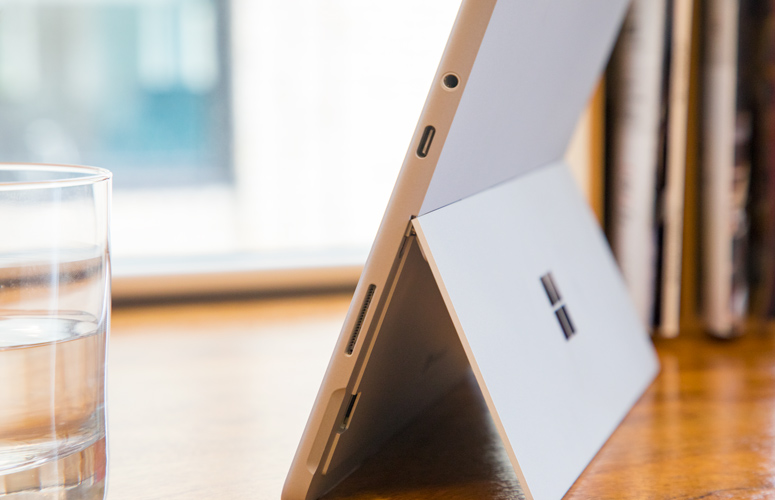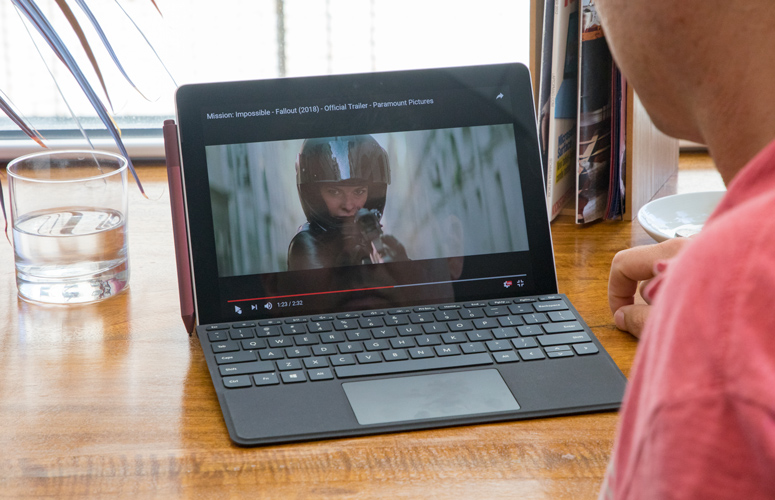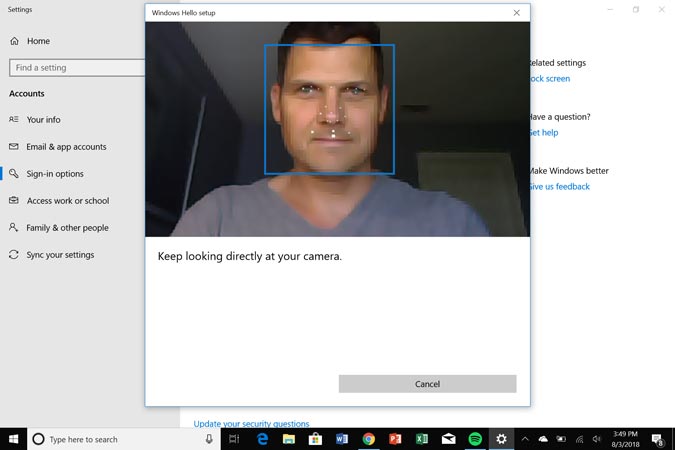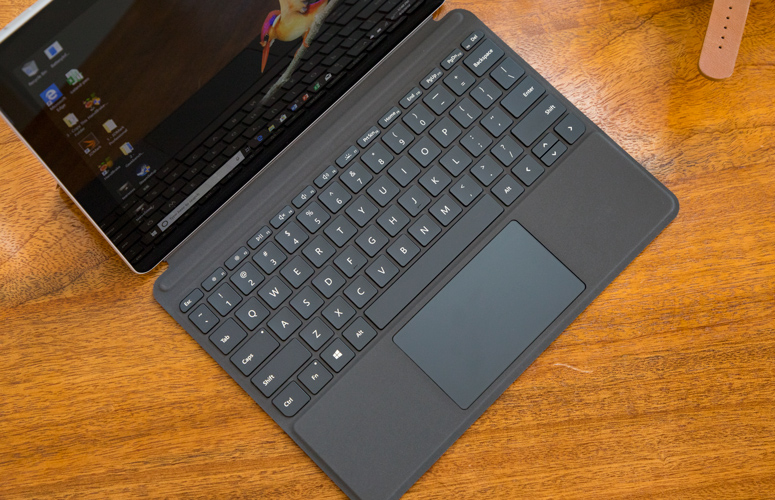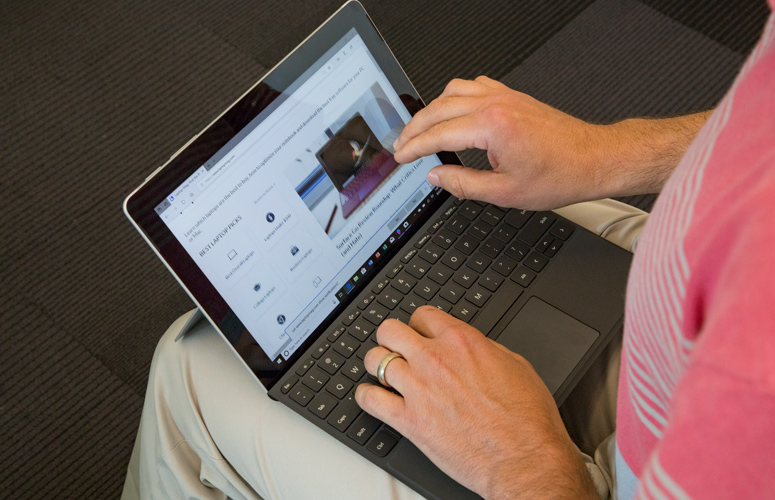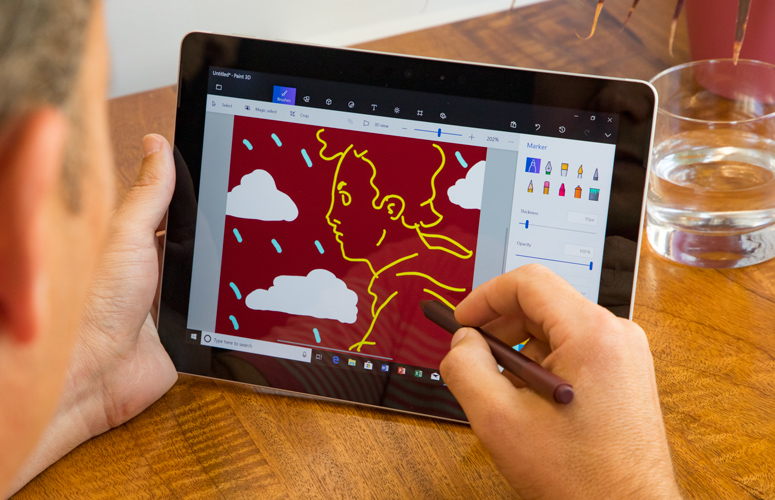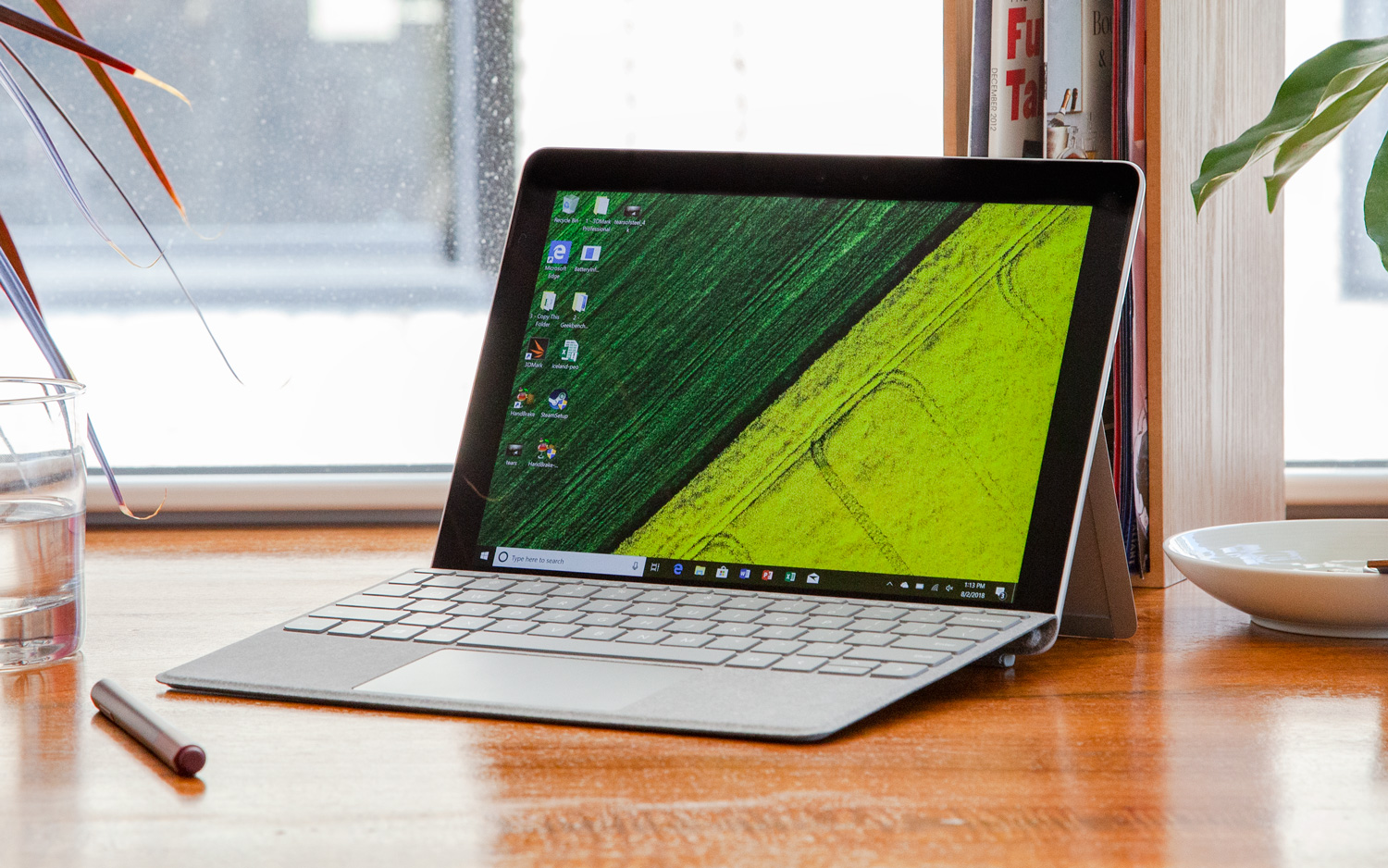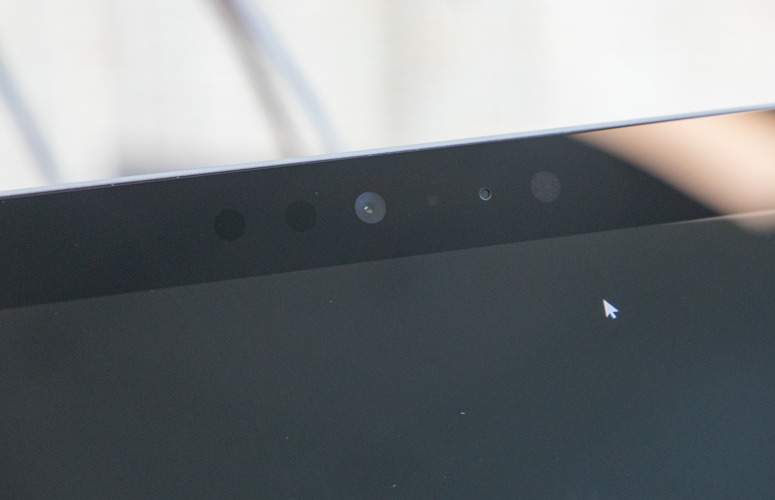Laptop Mag Verdict
The Surface Go is very close to an ideal budget tablet and mini laptop in one device, but short battery life holds it back.
Pros
- +
Colorful and bright display
- +
Comfy backlit keyboard with touchpad
- +
Faster than most budget Windows laptops
- +
Windows Hello for facial recognition logins
Cons
- -
Short battery life
- -
Thick bezels
- -
Keyboard and pen cost extra
Why you can trust Laptop Mag
While other tablets like the 9.7-inch iPad and the new Samsung Galaxy Tab S4 are trying to pivot toward productivity, the Surface Go (starting at $399, $599 as tested) already has two key advantages over those slates that cement it on our best tablet list. The first is that Windows is a heck of a lot more versatile than iOS or Android (even with a desktop-like skin on top). The second is that the Surface Go's keyboard actually includes a touchpad, so you can control the cursor without resorting to the touch screen or pen.
The Surface Go has some other things going for it, too. The 4GB entry-level model is very affordable, and even when you throw in the keyboard you're still at a reasonable $499. But if you want a Surface Pen that's another $99. Other pluses include a vibrant display and peppy performance from the Pentium processor. However, the battery life leaves a lot to be desired.
Design
When you think of a budget Windows machine, you usually don't think of sturdy build quality, but that's exactly what you get with the Surface Go. The silver magnesium case looks and feels more premium than competing Windows machines in this price range. Plus, you get the same nifty kickstand that you'll find on the more expensive Surface Pro, which makes it easy to switch from tablet to laptop mode, or just standing up the tablet so you can binge on Netflix.
It's not all good news, though. The Surface Go has a thick bezel around the display, which makes we wonder whether Microsoft could have squeezed an 11-inch screen into this design with a screen that was more edge-to-edge.
As a slate, the Surface Go weighs just 1.15 pounds, and it still weighs a featherweight 1.66 pounds with the keyboard. By comparison, the aluminum 9.7-inch iPad starts at an even lighter 1.03 pounds, with its Smart Cover adding 0.24 pounds.
As you might imagine in a design that's 0.33 inches thick, there's not much room for ports. There's one USB-C port, a Surface Connect port (for charging and docking) and a microSD card slot to go along with the headphone jack.
Sign up to receive The Snapshot, a free special dispatch from Laptop Mag, in your inbox.
Display
The 10-inch PixelSense display on the Surface Go may be small, but it offers plenty of pop. When watching the Mission Impossible: Fallout trailer, I could make out fine details in Henry Cavill's beard on the the 1800 x 1200-pixel screen, and a speeding olive-green BMW gleamed as it came to a screeching halt.
While the panel on the 9.7-inch iPad is even higher-res at 2048 x 1536 pixels, I don't have any complaints about the Surface Go's canvas.
The Surface Go's screen delivered excellent results in our labs, too. It averaged 415 nits of brightness, which is lower than the iPad but miles above the average budget laptop (245 nits).
The 10-inch PixelSense display on the Surface Go may be small, but it offers plenty of pop.
The Surface Go surpassed on the iPad on color reproduction, registering 129.2 percent of the sRGB color gamut compared with 119 percent for Apple's tablet. The average budget laptop gets just 87 percent, and a 2-in-1 like the Lenovo Flex 6 11 mustered only 71 percent.
The touch screen on the Surface Pro proved responsive as expected, whether I was scrolling or pinching-to-zoom on photos. However, touching the right icon on the bottom of the screen proved difficult when I had multiple apps open, as the icons are tiny.
Windows Hello
Logging in to the Surface Go is a cinch if you enable Windows Hello facial recognition. After a few seconds, I could bypass the lock screen just by looking at the front of this tablet.
You set the feature up by staring into the camera. Windows Hello isn't as secure as a password or Apple's 3D Face ID scans on the iPhone X, but it's convenient to have.
Audio
The Surface Go packs a good sonic punch for it size, even if the audio sounds a bit harsh at max volume. When I streamed The Strokes' "Reptilia" through the Surface Go's speakers, Julian Casablancas' gravelly vocals and the jangling guitars filled my home office with sound.
MORE: Our Favorite Tablets for Work and Play
In the Mission Impossible: Fallout Trailer, Ving Rhames' whisper-like banter came through clearly even from a few feet away, and the machine-gun fire from a speeding helicopter could be easily heard despite the blaring soundtrack.
Keyboard and Touchpad
The optional keyboard for the Surface Pro is surprisingly comfy, and I like that it's backlit. But the typing experience is better on a desk than it is on your lap.
I typed the most of this review on the Surface Go's $99 Signature Type Cover, which comes in black and has a nice microfiber finish. You can also opt for a more premium soft-touch Alcantara Type Cover for $129, which comes in Platinum, Burgundy and Cobalt Blue.
Because this is a 10-inch design, I had to get acclimated first to the slightly smaller keys, but Microsoft deserves credit for offering a decent 0.9 mm of key travel. That's better than the MacBook Pro's 0.55mm of travel on its butterfly keyboard, but its less than what you'll find on a clamshell 2-in-1 like the Lenovo Flex 6 11 (1.3mm).
The keyboard for the Surface Pro is surprisingly comfy, but the typing experience on your lap is not as good as when it's resting on a desk.
On the 10fastfingers typing test, I averaged my usual 70 words per minute, but my accuracy was just 88.6 percent when I'm usually closer to 93 percent. I think that's because the keys feel closer together on this layout.
Although the Surface Go felt pretty stable on a table or desk when typing, I experienced a trampolining effect with this 2-in-1 in my lap. The display would jump up and down as I typed, which, I think, is partially because of how light this machine is.
I'm happy to report that the touchpad proved accurate during my testing, and it provided a satisfying click when I pressed down. Windows 10 gestures worked well, too, such as swiping with three fingers to switch between apps.
Surface Pen
If I were to buy the Surface Go, I'd probably skip the Surface Pen, but this $99 accessory does offer some benefits. You can markup and annotate documents and websites, take notes and draw and sketch in a growing number of apps. Having a pen also comes in handy for electronic signatures, which is great for business users in the field.
I handed the Surface Pen to our deputy photo director, Jef Castro, and he said it felt responsive and sensitive when he made a sketch in Paint 3D.
Performance
No, it's not as fast as the iPad on certain benchmarks, but the Surface Pro felt speedy in my everyday use. The standard configuration I tested features a Intel Pentium Gold 4415Y processor, 4GB of RAM and 64GB of eMMC storage. But we also have the performance results from the more premium $548 model, which ups the RAM to 8GB and the storage to a 128GB SSD.
The Surface Go did an admirable job handling my typical workload, juggling 15 open tabs in Google Chrome and the Stride messaging app while streaming Spotify. I noticed a bit of lag as I switched from one tab to another, and at one point the camera app froze and forced me to restart. Overall, though, I was pleased with the Surface Go's performance, given its price.
MORE: The Best Laptops for Every Need
On Geekbench 4, which measures overall performance, the 4GB Surface Go scored 3,749, while the 8GB model with its 128GB SSD hit 3,900. Both of those scores beat the budget laptop average of 3,159. The Asus E403NA (Pentium N4200, 4GB RAM, 128GB eMMC) scored in between the two Surface Go devices with 3,849. However, the 9.7-inch iPad's A10 Fusion processor notched an even higher 5,983.
We definitely saw a difference in performance between the entry-level Surface Go and the $549 model on our SSD test, which involves copying 4.9GB worth of data. The 64GB eMMC in the entry-level Go hit 87.74 megabytes per second, while the 128GB SSD model reached 154.2 MBps. Still, both marks are well above the budget laptop average of 44.2 MBps.
The two Surface Gos were closer on our productivity test, which involves matching 65,000 names and addresses in Excel. The $399 model took 4 minutes and 45 seconds, and the $549 version was only a few seconds faster at 4:42. The typical budget laptop takes a more leisurely 7:15.
Graphics
Since both Surface Go models have the same Intel HD Graphics 615, it was not a surprise to see them both score just over 41,000 on the 3D Mark Ice Storm Unlimited test. That's nearly double the budget laptop average and what Lenovo's Flex 6 11 turned in.
To try out the Surface Go's graphics performance, I fired up the Asphalt Legends 9 racing game from the Windows Store. It ran pretty smoothly even as I flipped my car upside down and performed multiple nitro boosts. I noticed only a few skipped frames here and there.
Battery Life
The biggest weakness of the Surface Go hands-down is the battery life. On the Laptop Mag Battery Test, which involves continuous web surfing at 150 nits of screen brightness, this 2-in-1 lasted just 6 hours and 6 minutes. That's about 4 hours less than the tablet average (10:05) and the Apple's iPad (10:07).
MORE: Laptops with the Longest Battery Life
Budget Windows' laptops like the Lenovo Flex 6 11 (9:11) and Chromebooks like the Acer Chromebook Spin 11 (8:41) also last a lot longer on a charge.
The biggest weakness of the Surface Go hands-down is the battery life.
Anecdotally, the Surface Go's battery life was just OK. After using this system starting at 11 a.m. and running through 3 p.m., with a half-hour lunch break, I had about 24 percent battery remaining.
Cameras
The Surface Go comes with both a 5-megapixel front camera and a 8-MP rear camera, and the former impressed me more than the latter. A self-portrait I snapped in my office came out relatively clear, and there wasn't much ambient light.
However, a shot I took of flowers had blown out yellows and whites, even though it was overcast at the time. On the plus side, I could make out fine details in the green leaves.
What does the Surface Go cost?
The Surface Go starts at $399 for a Intel Pentium Gold Processor 4415Y, 4GB of RAM and 64GB of storage. There's also a $549 model, which gives you double the RAM and a bigger and faster 128GB SSD.
If I were to buy the Surface Go, I'd go for the 128GB SSD; after loading our benchmarks and just a handful of apps, the C drive said it had only 4.78GB left. You can always add microSD for storage, but it's not ideal for running apps off an external card.
Keep in mind that these prices are before you include accessories. The Type Cover starts at $99, and the Surface Pen is another $99. So, if you wanted the premium Surface Go with both add-ons, you'd be looking at close to $750.
Microsoft will also be making an LTE version of the Surface Go available, but the pricing and availability are not yet known.
The faster Surface Pro, which sports a bigger 12.3-inch screen, starts at $799 before you add the same accessories. So it could be tricky figuring out which Surface to get, especially considering the Surface Pro lasted 1.5 hours longer on our battery test.
Bottom Line
In many ways, the Surface Go is the ultimate secondary PC. Although small, the 10-inch display is bright and colorful; the Pentium performance is pretty solid for the price; and the build quality and sheer portability can't be beat. Plus, the keyboard is quite comfortable for speedy typing, even though it's more of a challenge when it's on a lap.
The one thing that prevents the Surface Go from being an Editors' Choice pick is its short battery life. And yet, there's not really a great alternative to the Surface Go other than the iPad, which isn't really a good apples-to-apples comparison. The iPad is faster and offers longer battery life, but its keyboard lacks a touchpad and a lot of people simply want to run Windows on the go.
Overall, I like the Surface Go more than I thought I would. But I wouldn't leave the charger at home.
Credit: Laptop Mag
Microsoft Surface Go (4GB) Specs
| Bluetooth | Bluetooth 4.2 |
| Brand | Microsoft |
| CPU | Intel Pentium Gold 4415Y |
| Company Website | http://www.microsoft.com |
| Display Size | 10 |
| Hard Drive Size | 64GB |
| Hard Drive Type | SSD |
| Highest Available Resolution | 1800 x 1200 |
| Native Resolution | 1800x1200 |
| Operating System | Windows 10 Home |
| Ports (excluding USB) | USB-C |
| RAM | 4GB |
| Size | 0.33 x 9.65 x 6.9 inches |
| USB Ports | 1 |
| Weight | 1.15 lbs |
| Wi-Fi | 802.11 a/b/g/n/ac |



